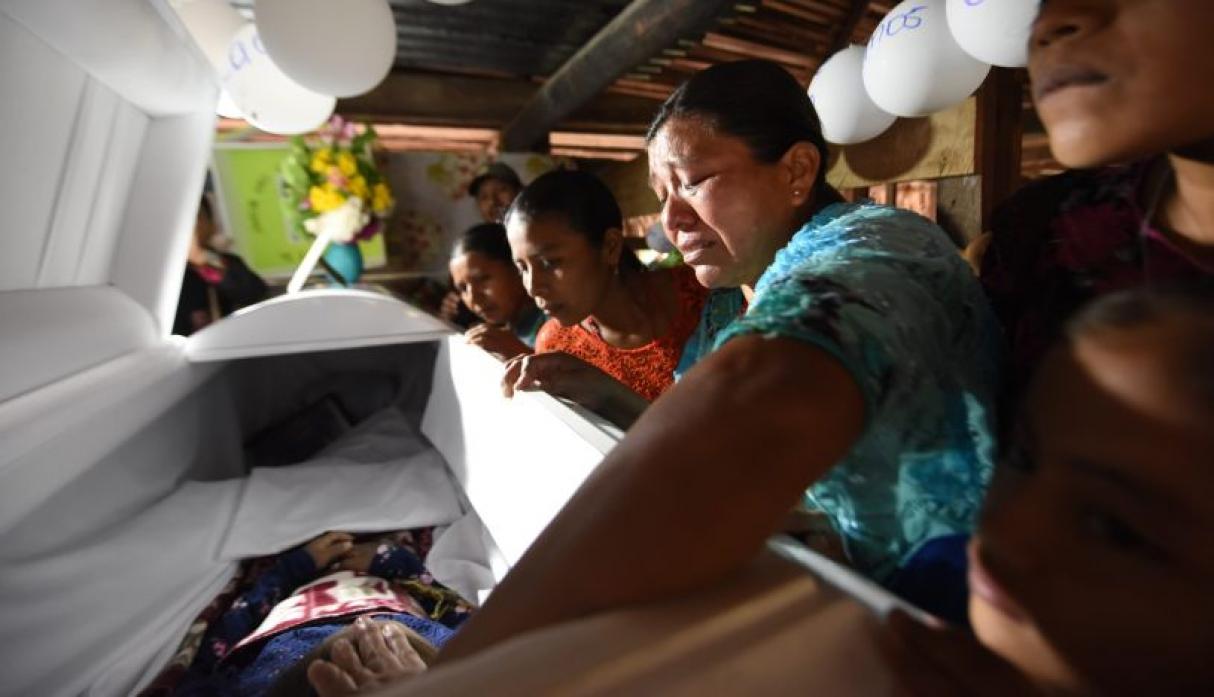by Gabriel M Schivone
The death of seven-year-old Jakelin Caal in US custody follows decades of US-sponsored devastation in her home countryA grainy cellphone image from a small indigenous Guatemalan village shows seven-year-old Jakelin Amei Rosmery Caal Maquin, wearing a blue blouse and jeans and looking diffidently into the camera with her arms hanging at her sides. Not long after the photo was taken, she accompanied her father on the over 2,000-mile journey to try and reach the US. She died while in US border patrol custody after arriving at a New Mexico port of entry to claim asylum.
Traveling with a father, like Jakelin was, accounted for the main reasons small children were regularly separated under Barack Obama (the other reason being the mass incarceration program Operation Streamline), though Donald Trump outmatched his predecessor in sheer scale if not in practice.
The father and daughter fled their small village in Alta Verapaz, one of the areas targeted for annihilation during two successive, US-backed regimes over the Carter-Reagan years, atrocities that a 1999 UN truth commission deemed “acts of genocide” perpetrated against indigenous Mayan ethnic groups that included Jakelin’s Q’eqchi’ people. Of the 200,000 people killed, eight out of 10 were indigenous.
The targeted scale of death, contrasted by the lack of global action and public outcry, led a group of international lawyers to call the period a “silent holocaust”.
The term “holocaust” isn’t exaggerated. Just over 100 miles from Jakelin’s village, so many bodies were piling up that a Guatemalan military base in Huehuetenango (one of those that proliferated under Kennedy-era military funding programs) operated a crematorium to incinerate the bodies of “the disappeared”.
Guatemala’s unique national criminal trials in recent years, prosecuting lower soldiers, senior officers and heads of state, have implicated US national security doctrine, first instituted by Kennedy under the guise of fighting communism. US military and embassy officials over the years admitted to, even took credit for, the formation of informal death squads to assist military and security forces in the butchery.
An estimated 10,000 people alone were killed in the first three months after a March 1982 military coup by President Reagan’s favorite “man of great personal integrity”, General Efraín Ríos Montt, trained at Fort Bragg, whose forces averaged 19 massacres per month. Whole villages (over 400 were destroyed) were literally burned off the face of their earth and their inhabitants killed, often gruesomely.
When people started fleeing the nightmare in record numbers (also from US-backed forces in El Salvador), the Reagan administration stepped up border security with methods first tried and tested in Guatemala’s US counterinsurgency “laboratory”.
Reagan denied asylum claims wholesale to people like Jakelin and her father by referring to them as economic migrants unworthy of asylum, instead of taking responsibility for creating the conditions of political economy that encompass both migrants and refugees. By 1984 a mere 0.79% of Guatemalan asylum applicants had their requests grants and, by the next year, Reagan was deporting 1,000 Central Americans per month back to the death squads. Then, as today, US civil society sanctuary efforts began.
Jakelin’s mother recalls her daughter’s dream to send money home from the US, a dream she shared with other members of Guatemalan civil society who implored President Clinton in 1999 to relax immigration controls, which skyrocketed under his watch, so that these valuable remittances could continue. Clinton was in Guatemala City the day the UN released its report on Guatemala. Looking genocide survivors in the face, he admitted the decades of decisive US military assistance “was wrong” but flatly rejected their pleas for immigration reform, because, he said, “we must enforce our laws”.
Other forms of denial run deep. Obama’s former UN ambassador, Samantha Power, wrote an authoritative study on genocide, A Problem from Hell: America and the Age of Genocide, whose index fails to even list “Guatemala”. US-backed torture of Guatemala traces back to the Franklin D Roosevelt years and prior, but today conditions have only grown worse.
Every time the media fail to report this historical wreckage from which Jakelin’s people are still fleeing across the US-Mexico border; every time US officials fail to treat these survivors with compassion – indeed massive financial reparations would be more appropriate – contributes to an active case of genocide denial.
There’s a scene in Steven Spielberg’s film Schindler’s List where the protagonist Oskar Schindler watches, on horseback from the safety of a distant bluff, the Nazi liquidation of the Warsaw ghetto. Nazi soldiers are killing people indiscriminately, yet Schindler can’t take his eyes off a little girl in a red coat, about the same age as Jakelin, who scuttles, unscathed, along the blood-soaked cobblestones – later to be seen in a pile of bodies. In a 2017 HBO documentary, Spielberg reflects that the red-coated little girl of Jakelin’s age “was less about what turned” Schindler’s sympathy and “more that the world turned a blind eye on the holocaust and the industrial process of wholesale murder”.
In other words, the Nazi holocaust was once, like Guatemala’s, a “silent” one.
While Jakelin, the little girl in the blue blouse, rates headlines for the time being, an enduring question remains. When will Guatemala’s suffering grow louder than the din of US interests – from Roosevelt to Kennedy to Reagan to Clinton to Obama to Trump – and fill the silence of inaction with demands for justice and accountability on this side of the border?
(Gabriel M Schivone is an immigration asylum sponsor and humanitarian aid volunteer on the Arizona/Mexico border).



